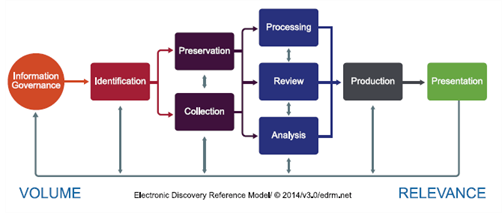About eDiscovery
In the eDiscovery world, the Electronic Discovery Reference Model (EDRM) has been the standard conceptual framework followed by most eDiscovery cases. The EDRM appears to move linearly. Data is identified, preserved and collected, then processed, reviewed, and analyzed before moving to production and presentation.

Although this process does gradually narrow your data set, a sizable bulk of electronic documents is the result of the Preservation and Collection stages. The depth and breadth of the collected information, in the form of documents, emails, and shared cloud files from different locations, be it in-house or on-premise, can be broad and sometimes overreaching. Whether this information is relevant to the case or not does not matter. It must all be analyzed, searching for the 10% of relevant information—a costly and time-consuming endeavor involving lawyers, paralegals, case managers, and auditors.
From a general perspective, the standard eDiscovery model appears to move linearly; data is identified, preserved and collected, then processed, reviewed, and analyzed before moving to production and presentation.
This is where IPRO steps in and shakes things up in eDiscovery... because why collect what you don't need? The problem is two-fold: first, since you are the owner of the collected information, you have the best knowledge of where relevant information resides and what constitutes relevant information; second, the legal team receiving the information (often subcontractors to the outside counsel) charge fees proportional to the amount of data that needs to be reviewed.

You can take control of the eDiscovery costs and timelines by being smarter during the collection process. Since you own the data, you can reduce the amount of data sent for review. This not only reduces costs, but it shortens the timeline to send reviewed data to corporate counsel.
The same thing applies to outside legal counsel. They have every reason to reduce the cost of eDiscovery and make their efforts with the customer more effective. Furthermore, they can get directly involved in helping customers reduce the cost by participating in this enhanced collection process.